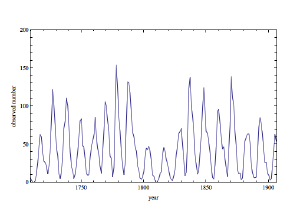Post
Spot the Pattern
1 October 2012
We generally think of the Sun as a constant in our lives. It rises and sets regularly, and seems to be an unchanging sphere of brilliant light. In fact the Sun has a turbulent surface with prominences that fly off its surface, granules caused by convection in its upper layers, and even the appearance of slightly cooler regions known as sunspots.
Of all these features, sunspots are relatively easy to observe, and were the first evidence that the Sun is not a fixed constant. Since the early 1600s we’ve been able to make reasonably accurate counts of the number of sunspots over time. I’ve plotted some historical data in the figure below.
 BK
BKOne of the most obvious patterns you can see is the wide variation in sunspot activity over a relatively short period of time. This is known as the 11-year cycle due to its average rate, though the cycle is sometimes longer or shorter. There are other patterns as well, such as the Gleisberg Cycle, which lasts 80 - 90 years. There have also unusual periods such as the one from about 1645 to 1715 when there was very little sunspot activity at all, known as the Maunder minimum.
Sunspot activity now allow us to gain a better understanding of the upper regions of the sun, and that in turn gives us a better understanding of the sun as a whole.
But it all began by spotting a pattern.